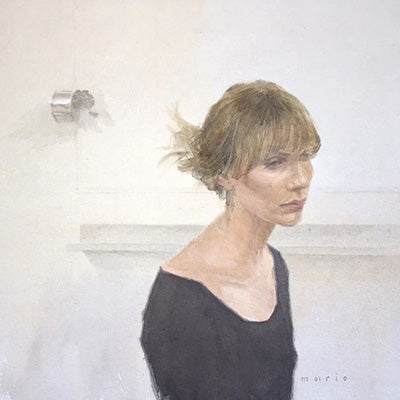Your Cart is Empty
Mario Andres Robinson (“Beginner Watercolor Portraits”) is a full-time artist, residing in Point Pleasant, New Jersey. After his artistic gift was discovered by a fifth grade teacher, a creative explosion was sparked in Robinson as a pre-teen. He attended Pratt Institute in Brooklyn, New York and has been painting professionally for 24 years. He works across media in oils, watercolor and pastel.

What are the steps you go through in your process? What problems are you trying to work through in each step?
During my working process, I’m working through three distinct steps. Establishing proper value relationships is a vital component in my work. This requires me to employ a monochromatic block-in to assign values and create a neutral surface on which to work.
The next step acts as a bridge between the three phases. I refer to this stage as the “dead” color pass. The introduction of muted washes on watercolor allow the grey underpainting to show through, while moving the painting towards a colorful tone.
Lastly, slightly thicker glazes of full color are applied in order to exaggerate the contrast between the lightest lights and the darks.

Why is planning important? What does it give you in the painting process that you wouldn’t have without it?
Planning is important to my process, due to the unpredictable nature of watercolor. Creating thumbnail sketches of preparatory studies improves my muscle memory and affords me the opportunity to work in a more fluid manner in the finished work.

What are the most important things for beginning watercolor students to understand about their materials? Where do you see students running into problems with materials?
A common mistake I find beginner watercolorists making is having more art materials than required. This is especially true as it pertains to the amount of colors needed. My palette consists of seventeen colors. When mixed, I can achieve any color in nature, portraiture or interiors with that range.
Another issue is usually a proper knowledge of brushes. Synthetic brushes perform differently than brushes made of natural hair. Choosing the right sized brush for the task at hand will also determine the outcome of the work.
You create big puddles of washes (as in muffin tins filled with water and pigment). Why do you work this way? What does it allow you as an artist?
When I began working in watercolor, I attempted to utilize the shallow wells allotted on standard watercolor palettes. I found myself running out of watercolor, mixed for larger areas of my painting. I moved on to mixing larger pools of color in plastic containers, prior to discovering the plastic muffin pans I currently use. They allow me to properly measure the water to pigment ratio in my watercolor mixes and prevent stoppages in my workday in the effort to have an ample amount of watercolor with which to paint.

What makes a good reference photo for portraiture? What does the reference photo need to have?
First, a useful reference photograph should possess good lighting in which the subject’s features and flesh tone are readily accessible. Second, it’s helpful if the photograph was properly in focus. Third, the image being photographed should be interesting. Photography and paintings read differently. An artist should not assume that a photograph will translate when used as a reference photograph in the painting stage.

Where do you do the composition piece of your watercolor portrait? (Is that in camera or on the paper?) What questions are you asking yourself in order to get to a good composition?
My compositions are always worked out on paper. The most effective tool for problem solving is a preparatory sketch. Loose graphite renderings can lead to successful ways of either placing objects in a work or eliminating elements for an impactful result. I’m constantly asking myself whether or not a painting is interesting outside of my personal bias.
Portraiture can feel overwhelming for beginning painters: Where do you suggest they begin if their goal is to capture a likeness?
I suggest beginning painters begin with painting self portraits as often as possible. Each individual is more knowledgeable of their own likeness than anyone in the world. This can give the artist a true sense of how acute they are in capturing a likeness. Outside of that, I would suggest a consistent practice of the craft. There’s no substitute for hard work.

How does someone start learning to see how color temperature moves across the face?
I would suggest beginning artists set up light and cool sources to easily determine how both temperatures affect the surface of the skin. I find identifying these shifts in color to be highly intuitive.
How important is drawing? What does being able to draw give you as an artist?
Drawing is the most important element of watercolor painting. The success of a realistic watercolor is largely determined by the accuracy of the initial drawing which underlies the layers of color. Unlike oil paintings, the drawing offers a skeletal structure upon which the watercolor rests. The ability to draw aids the artist in their understanding of the accuracy of the object they seek to capture.

What are the biggest challenges you see your students running into when it comes to painting a portrait? What advice do you give them?
The biggest challenge I see my students face is applying watercolor in a linear manner, devoid of hard watermarks. My advice is to add water to the surface of the paper prior to applying watercolor. This will give the watercolor a softer appearance and soften edges.
The learning curve is slightly higher with watercolor than that of other mediums. There will be many triumphs as well as heartbreaks. It’s important for artists to take it all with a grain of salt and enjoy each experience.
